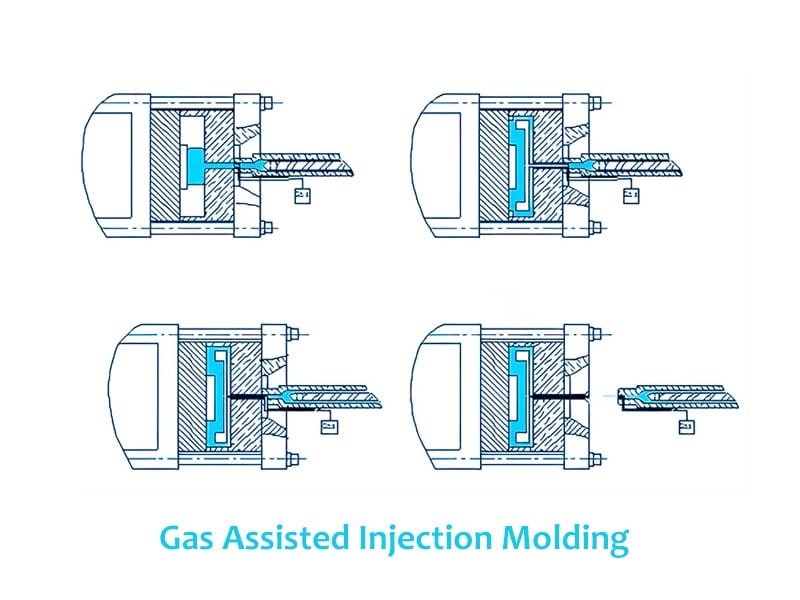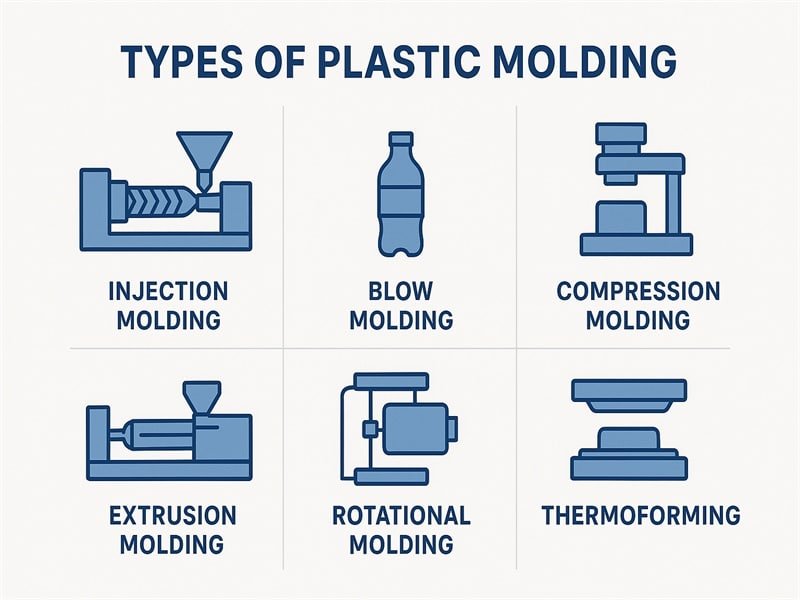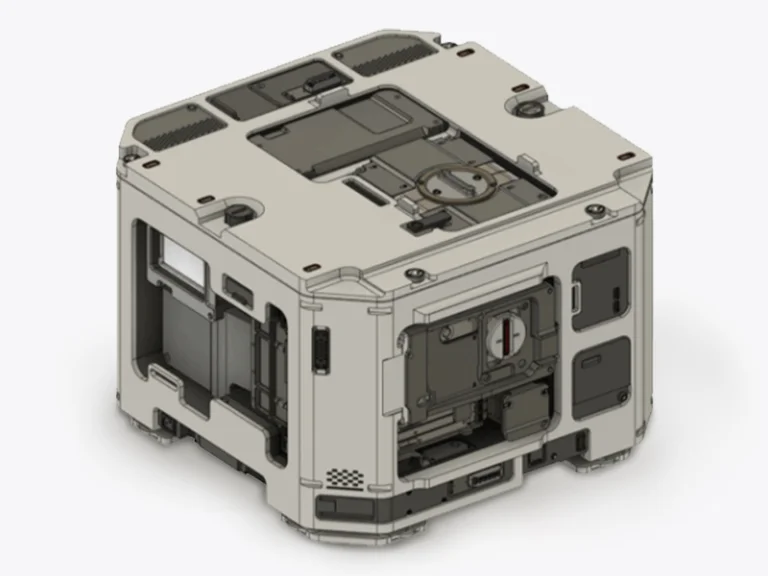Ribs and gussets are essential design features in injection molded parts that significantly enhance structural integrity and performance without adding excessive material or weight. In this post, we will explore what are ribs and gussets, and compare the different between ribs and gussets in injection molding design.

When to Incorporate Rib and Gussets Features in Your Design
Incorporating ribs and gussets into plastic part designs is crucial in several scenarios to enhance strength, prevent defects, and optimize material usage. Here are some key situations where rib and gussets design is particularly beneficial:
In High-Stress Applications
When a part experiences significant loads or stresses during use, such as in automotive components, structural housings, or load-bearing applications, ribs and gussets are essential for ensuring durability and preventing failure. By strategically placing ribs and gussets, designers can reinforce critical areas and distribute stress evenly across the part. Ribs and gussets are essential for enhancing stiffness without adding bulk.
Lightweight Requirements
In industries where weight savings are critical, such as aerospace or automotive, using ribs and gussets allows for thinner walls while maintaining necessary strength. This approach reduces material usage and part weight without compromising performance.
Preventing Warpage
Thick walls can lead to uneven cooling during the injection molding process, causing warpage and other defects. Ribs and gussets help maintain structural integrity while keeping wall thickness minimal, thereby reducing the risk of warpage.
When Supporting Complex Features
When parts include features that require additional support, such as mounting points, connectors, or isolated bosses, ribs and gussets can provide the necessary reinforcement. By connecting these features to the main walls or using strategically placed ribs and gussets , designers can ensure they remain structurally sound.
When Need to Improve Mold Flow
Carefully positioned ribs and gussets can enhance the flow of molten plastic into the mold, facilitating better filling and reducing the likelihood of defects such as voids or incomplete fills. This is particularly important when dealing with complex part geometries or tight tolerances.
Enhancing Stiffness
If a part needs to resist bending or deformation under load, ribs and gussets are essential for increasing stiffness without adding excessive weight or thickness. This is crucial in applications where strength is required but space is limited.
What are Ribs in Plastic Design?
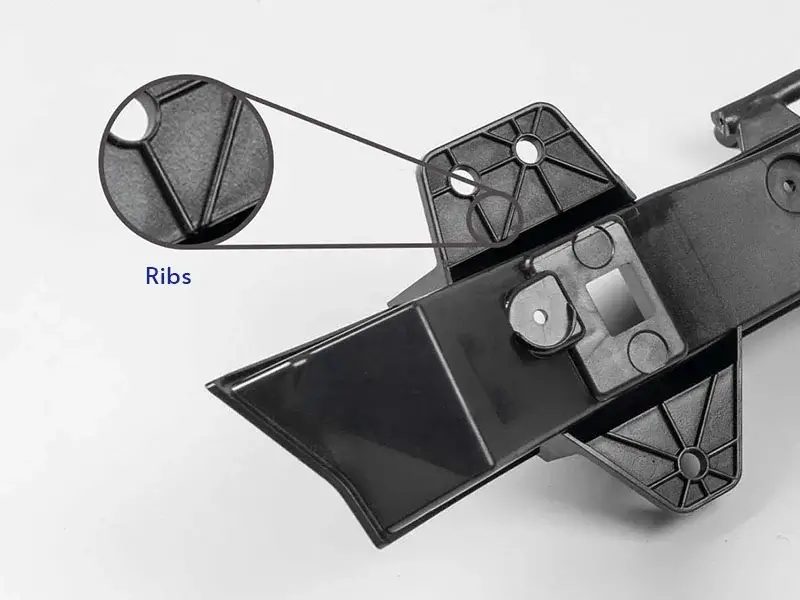
Ribs are thin, wall-like structures that extend perpendicularly from the main walls or surfaces of an injection molded part. Their primary purpose is to provide additional support and stiffness to the part to add strength and rigidity without significantly increasing overall wall thickness or material usage.
Plastic Parts Ribs Design Consideration
Ribs Thickness Recommendations:
Rib thickness should be 60-75% of the thickness of the wall it’s supporting. For example, if the main wall is 5mm thick, the rib should be 3-3.75mm thick. If plastic ribs are too thick, they can cause sink marks on the opposite side of the part. Conversely, if they are too thin, they may not provide sufficient reinforcement.
Ribs Height limitations:
The maximum height of a plastic rib should not exceed 3 times the thickness of the primary wall it’s supporting. This prevents issues with cooling and part ejection. Taller ribs can provide more support but may also create molding challenges, such as difficulties in filling and increased potential for warpage.
Ribs Spacing Considerations:
Ribs should be spaced no closer than their height. The minimum space between ribs should be at least twice the wall thickness. This ensures proper cooling and prevents thin, damage-prone sections in the mold.
Ribs Draft Angles:
Ribs require draft angles of 0.25-2 degrees, with 0.5-1 degrees being most common. This facilitates part ejection from the mold without damage.
What are Gussets in Plastic Design?
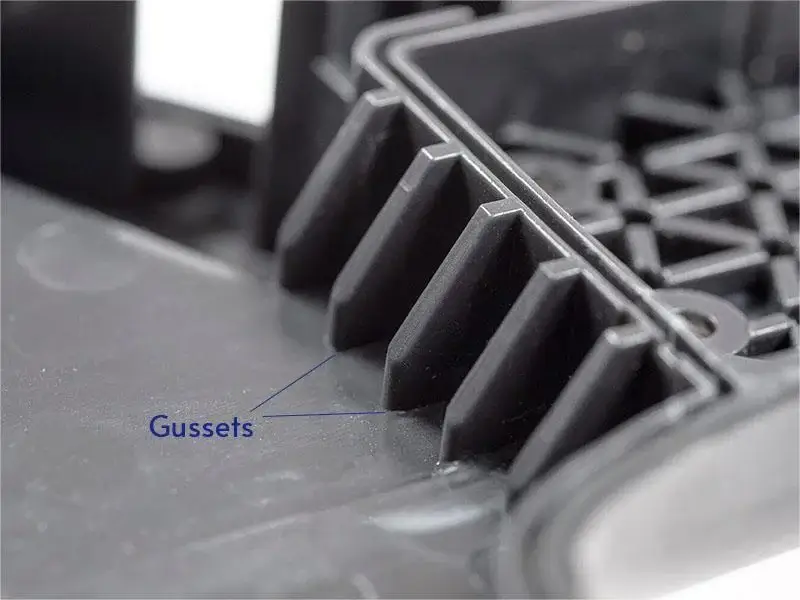
Gussets are wedge-shaped supports that strengthen parts by reinforcing corners, side walls, and bosses. These triangular or trapezoidal protrusions extend from one surface to another, typically at right angles, and connect support features to the floor of a part. Doing so, gussets distribute weight, enhance structural integrity, and prevent parts from breaking under stress, especially at joints and connections where two or more surfaces meet.
Plastic Parts Gussets Design Considerations
Shape and Placement:
Gussets are typically triangular but can also be other shapes as long as they effectively reinforce the part. They should be placed at corners, junctions, and areas where additional support is needed, such as around bosses, at the base of walls, along edges, or around mounting points.
Thickness and Height Recommendations:
The thickness of a gusset should follow similar guidelines to ribs, generally being 60-75% of the thickness of the wall it supports.
The height of a gusset should not exceed 3 times the thickness of the primary wall to prevent issues with cooling and part ejection.
Corner Design Principles:
Gussets should have rounded corners, either with a radius, bevel, or chamfer, to avoid sharp angles that can create air pockets and voids during the molding process. This ensures better material flow and reduces the risk of defects.
Optimize Reinforcement and Support Design!
What is the Difference Between Ribs and Gussets?

While both ribs and gussets are used to enhance the structural integrity of injection molded parts, they differ in shape and application. Ribs are thin, straight walls that connect larger surfaces, providing support and rigidity, often running perpendicular to the main surfaces.
Gussets, on the other hand, are wedge-shaped supports that reinforce specific points, such as corners and junctions, to distribute weight and prevent stress-related failures, usually triangular. Both features follow similar design principles but are applied differently based on the specific needs of the part.
How Ribs Design Enhancing Strength and Durability?
Internal Support: Ribs add internal support to walls and other features like bosses, distributing loads more evenly and reducing the risk of part failure under stress.
Weight Reduction: By replacing thick wall sections with strategically placed ribs, designers can reduce the weight of the part while maintaining or even enhancing its strength. This also helps in reducing material costs and improving cooling times.
Stress Distribution: Properly designed ribs help in distributing stress across the part, preventing stress concentrations that can lead to cracks or breaks.
Improved Stiffness: Ribs increase the stiffness of the part, making it more resistant to bending and deformation under load.
How Gussets Enhancing Strength and Durability?
Reinforcement of Junctions: Gussets provide additional support at critical junctions, such as corners, side walls, and bosses, where parts are most likely to experience stress and potential failure.
Load Distribution: By reinforcing these areas, gussets help distribute loads more evenly, reducing the likelihood of part deformation or breakage under stress.
Prevention of Warpage: Properly placed gussets can help prevent warpage by ensuring even cooling and reducing internal stresses during the molding process.
Support for Bosses: Gussets are often used to support bosses, which are critical for assembly and fastening. This ensures that the bosses can withstand the forces applied during assembly and use.
Best Practices for Rib and Gusset Design
Based on the search results and the query, here are the best practices for rib and gusset design in injection molding:
Maintaining Uniform Wall Thickness:
Rib and gusset thickness should be 60-75% of the wall thickness they support.
In highly cosmetic areas, keep rib thickness at the intersection with the nominal wall to no more than 50% of the nominal wall thickness.
Avoid abrupt changes in wall thickness to prevent stress concentrations and cooling inconsistencies.
Avoiding Sharp Corners:
Use rounded corners for both ribs and gussets.
For ribs, the base should have a radius 0.25-0.5 times the width of the primary wall, with a minimum radius of 0.010 inches.
For gussets, use either a radius, bevel, or chamfer to avoid sharp angles that can create air pockets and voids.
Proper Placement for Load Distribution:
Position plastic reinforcement and gussets in line with material flow to improve filling.
Place ribs in load-bearing directions, such as long unsupported stretches of your part.
Connect bosses to walls or use connecting ribs rather than having stand-alone bosses.
Consider gate location when designing ribs or gussets to ensure proper filling.
Using Fillets and Radii:
Implement fillets where ribs meet walls to eliminate mechanical stress concentrations.
Use fillets to reduce stress and improve material flow.
Be cautious with fillet size – too small will fail to reduce stress, too large can create sink marks.
Common Challenges in Design Ribs and Gussets for Plastic
Based on the search results and the query about common challenges in designing ribs and gussets for plastic molds, here are the key points:
Lead to Sink marks:
Ribs and gussets that are too thick can cause sink marks on the opposite side of the part.
To prevent this, rib thickness should be 60-75% of the wall thickness they support. In highly cosmetic areas, keep rib thickness at the intersection with the nominal wall to no more than 50% of the nominal wall thickness.
Lead to Warpage:
Improper design or placement of ribs and gussets can lead to warping of the part, especially after cooling.
Ensure uniform cooling across the mold to prevent warpage.
Lead to Filling Issues:
Poorly located ribs and gussets can cause poor filling of the mold and lead to burn scars on the finished component.
Position ribs and gussets in line with material flow to improve filling.
Lead to Stress Concentrations:
Sharp corners in rib and gusset designs can create stress concentrations.
Use fillets and radii to eliminate mechanical stress concentrations.
Lead to Air Traps:
Isolated ribs or gussets can cause air entrapment, leading to venting issues.
Implement proper venting in the mold design to prevent air traps.
Lead to Cooling Issues:
Ribs that are too close together can lead to longer cooling times, increasing cycle time and part cost.
Space ribs are no closer than their height, with a maximum height of 3 times the primary wall thickness.
Conclusion
Ribs and gussets are essential design elements in injection molding that significantly enhance the structural integrity and performance of plastic parts. When properly implemented, these features allow designers to create stronger, more durable components while optimizing material usage and manufacturing efficiency.


